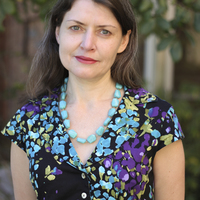- Gender, Design, Art History, Humanities, Cultural Theory, Second Great Awakening, and 20 moreReligion, Religion and Technology, Religion in North America, Design History, Design Theory, Furniture Design, American art/ Art of the United States, Aniconism, American Religion, Art and Art History, Languages and Linguistics, Design education, Art & Design education, Architecture, Research Methodology, Art and Design Education, Design History and Theory, Industrial Design, Design pedagogy, and History of Industrial Designedit
- Carma Gorman is an associate professor in the Department of Design at The University of Texas at Austin. Her specialt... moreCarma Gorman is an associate professor in the Department of Design at The University of Texas at Austin. Her specialty is the history of design, especially industrial design of the USA from 1890 to the present. Gorman earned her Ph.D. in art history in 1998 at the University of California, Berkeley. She has published reviews and articles on twentieth-century design in American Quarterly, Design and Culture, Design Issues, Studies in the Decorative Arts, and Winterthur Portfolio. Her American Quarterly essay on streamlined design and posture education of the 1920s-1940s was reprinted in the Organization of American Historians' collection The Best American History Essays 2008. Her primary-source anthology The Industrial Design Reader (2003), which Richard Buchanan described as "an essential text in design history courses," appears on reading lists at numerous U.S. and foreign universities. An edited collection of essays called Objects, Audiences, and Literatures: Alternative Narratives in the History of Design (2007), co-edited with David Raizman, has been reprinted in a paperback edition (2009). Gorman is a past president of the Design Studies Forum, and an associate editor of its peer-reviewed journal, Design and Culture.edit
Research Interests: Engineering and Panorama
class, in addition to disability. This will require UD to broaden its understanding of shifting population demographics beyond disability and aging to include the diverse spectrum of gender identity and related needs in the built... more
class, in addition to disability. This will require UD to broaden its understanding of shifting population demographics beyond disability and aging to include the diverse spectrum of gender identity and related needs in the built environment, as well as the lasting effects of de facto racial and economic segregation as issues of environmental and social justice. While these questions have more obvious relevance to Steinfeld and Maisel’s social justice approach to UD than Sanford’s rehabilitation approach, they can encourage designers to think broadly about how environmental barriers create oppressions with intersectional consequences, such as the impact of gender, race, and class segregation on public health and the distribution of resources. If the environment can perform a rehabilitative and enabling function to promote participation, UD must think about how it can be used to include other demographics, as well. Readers interested in technical and policy applications of UD will be engaged by Sanford’s book, which is more technical in tone; explains the systematic barriers to successful implementation of UD; and recommends new definitions, incentives, and policy solutions to improve UD’s efficacy and prevalence. Steinfeld and Maisel’s text comprehensively covers the range of legal, sociological, technical, historical, and practical issues faced by UD, but translates technical language and graphic representations of evidence to be more accessible to designers interested in the aesthetic and humanistic elements of UD. Ultimately, these books are highly theoretically sophisticated, nuanced in their assessment of UD’s application to design at all scales, and have relevance beyond just design practice. Although their focus remains largely on barriers related to disability and aging, both texts will be of interest to historians, design critics, and scholars in fields such as urban studies, disability studies, and feminist theory.
Research Interests:
Training in visual discernment via body mechanics instruction ultimately encouraged participants not only to understand the body as a mechanism, but also to judge mechanisms (such as formerly artless products) as beautiful to the degree... more
Training in visual discernment via body mechanics instruction ultimately encouraged participants not only to understand the body as a mechanism, but also to judge mechanisms (such as formerly artless products) as beautiful to the degree that they looked like bodies. In distinction, ...
Research Interests:
Research Interests:
Research Interests:
Page 1. Design Issues: Volume 22, Number 4 Autumn 2006 4 Henry P. Glass and World War II1 Carma R. Gorman Introduction The Art Institute of Chicago's 2005 exhibition 1945: Creativity and Crisis, Chicago Architecture and ...
Research Interests:
Research Interests:
Research Interests:
Research Interests:
Research Interests:
Research Interests:
Research Interests:
Research Interests:
Research Interests:
This review essay assesses recent (as of 2001) feminist scholarship on design.
Research Interests:
A review of three readers in design history/studies.
Research Interests:
... Troy's focus on Poiret in Couture Culture reveals the inherent theatrical-ity of Parisian haute-couture and haute-couturiers in the years prior to the First World War. ... Poiret, like other couturiers such as Jacques Doucet... more
... Troy's focus on Poiret in Couture Culture reveals the inherent theatrical-ity of Parisian haute-couture and haute-couturiers in the years prior to the First World War. ... Poiret, like other couturiers such as Jacques Doucet built up an extensive art collection. ...
Research Interests:
Research Interests:
Page 1. Industrial Strength Design An Exhibition Review Carma R. Gorman Industrial Strength Design: How Brooks Stevens Shaped Your World. Milwaukee Art Museum, Milwaukee, Wisconsin, June 7 to September 7, 2003. ...
